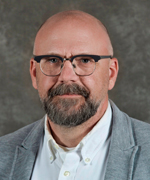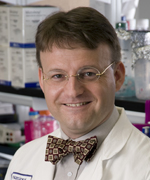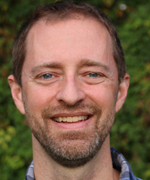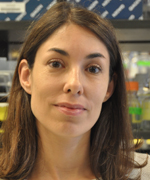Colleagues: Recently Tenured
CHRISTIAN C. ABNET, PH.D., M.P.H.; NCI-DCEG
Senior Investigator and Acting Chief, Nutritional Epidemiology Branch

Education: University of Oregon, Eugene, Ore. (B.S. in biology); University of Wisconsin, Madison, Wis. (Ph.D. in environmental toxicology); University of Minnesota, Minneapolis (M.P.H. in epidemiology)
Training: Cancer Prevention Fellowship, NCI
Came to NIH: In 1998 for training; in 2005 became an investigator in NCI
Selected professional activities: Editorial board, Cancer Epidemiology, Biomarkers and Prevention; steering committee, Barrett’s Esophagus and Esophageal Adenocarcinoma Consortium; chair, fellowship selection committee, International Agency for Research on Cancer
Web site: https://irp.nih.gov/pi/christian-abnet
Research interests: The major focus of my work is to understand the etiology of esophageal and gastric cancer. I am studying the complex pattern of the worldwide occurrence of these two malignancies across diverse populations—in China, Iran, Brazil, and Eastern and Southern Africa—that have high rates of these diseases. I am interested in how etiologic factors such as nutritional deficiencies, tobacco and alcohol use, and other lifestyle factors contribute to these cancers.
My research also examines the genetic contribution to worldwide differences in the incidence of gastric and esophageal cancer. The advent of genome-wide association studies has allowed my lab and I to pursue powerful genetic studies of these cancers in high- and low-incidence populations. In 2010, my colleagues and I reported that a single locus encompassing PLCE1 gene was the top hit for both these cancers among Chinese individuals in our study. I am carrying out additional studies of gastric cancer in Chinese populations and complementary studies of esophageal and gastric cancer outside China. This comprehensive examination across continents may provide the fullest understanding of the genetic contribution to the apparent etiologic differences in these malignancies.
Lastly, I am interested in the role of oral health and the oral microbiome and the risk of upper gastrointestinal cancers. In addition, I am leading studies to assess the impact of tobacco on the oral microbiome and its association with tobacco-related diseases.
BRIAN BROOKS, M.D., PH.D.; NEI
Senior Investigator, Pediatric, Developmental, and Genetic Ophthalmology Unit

Education: University of Maryland, College Park, Md. (B.S. in zoology); University of Pennsylvania, Philadelphia (M.D.; Ph.D. in pharmacology)
Training: Residency in ophthalmology and fellowship in pediatric ophthalmology at the University of Michigan (Ann Arbor); fellowship in clinical genetics at NHGRI
Came to NIH: In 2002 for training; moved to NEI in 2005 under the Physician-Scientist Development Program; in 2008 became tenure-track investigator in NEI
Selected professional activities: Founding director, National Ophthalmic Disease Genotyping and Phenotyping Network (eyeGENE®); board of senior consultants for the NIH-wide Undiagnosed Diseases Program
Outside interests: Camping with the family; bicycling; swimming; reading
Web site: https://irp.nih.gov/pi/brian-brooks
Link to Research in Action story: https://irp.nih.gov/our-research/research-in-action/seeking-better-vision
Link to video: http://www.youtube.com/watch?v=uyaj_NnfF3o&feature=youtu.be
Research interests: The goal of my research is to understand the causes and mechanisms of inherited eye diseases—especially those that affect children—and to use that knowledge to develop prevention strategies and treatments. Currently, my lab is focused on the genetics of uveal coloboma (a potentially blinding congenital eye malformation) and identifying potential treatments for albinism (an inherited disorder associated with reduced melanin pigment in the hair, skin, and/or eyes). Both conditions are developmental defects that can cause blindness in children.
To better understand the genetics of uveal coloboma, I am integrating basic laboratory experiments—including work in mouse and zebrafish disease models—with detailed clinical characterization of patients and their families at the NIH Clinical Center. This research will lead to improved molecular diagnosis, genetic counseling, and, perhaps, prevention and treatment strategies for patients.
In the field of albinism, my lab and I have identified an FDA-approved compound, nitisinone, that improves melanin pigmentation in a mouse model of one form of albinism called oculocutaneous albinism (OCA-1B). We are currently testing whether this drug is effective in humans with OCA-1B. We are also collaborating with the NIH Intramural Sequencing Center to identify other novel therapeutics for albinism.
CHRISTOPHER B. BUCK, PH.D.; NCI-CCR
Senior Investigator, Lab of Cellular Oncology

Education: University of Colorado, Boulder (B.A. in molecular, cellular, and developmental biology); Johns Hopkins School of Medicine, Baltimore (Ph.D. in cellular and molecular medicine)
Training: Postdoctoral training in NCI’s Lab of Cellular Oncology
Came to NIH: In 2001 for training; in 2007 became tenure-track investigator in NCI’s Center for Cancer Research
Selected professional activities: Co-organizer of the annual Think Tank meeting for NCI’s Center of Excellence in HIV/AIDS and Cancer Virology
Outside interests: Loves food—more of a gourmand than a gourmet; currently obsessed with almost all things fermented; likes mountain hiking; has great appreciation for many forms of modern music
Web site: https://irp.nih.gov/pi/christopher-buck
Research interests: Our group studies polyomaviruses. Most healthy adults chronically shed polyomavirus virions in their urine and from the surface of their skin. Although these lifelong infections generally don’t cause symptoms in healthy individuals, under conditions of immune impairment, polyomaviruses can cause disease. The human polyomavirus BK virus (BKV) causes kidney and bladder damage in organ-transplant patients, whereas its close relative the John Cunningham virus (JCV) causes a lethal brain disease in patients on immunosuppressive therapies and in individuals suffering from AIDS or human immunodeficiency virus. At least one skin-dwelling polyomavirus species, Merkel cell polyomavirus, causes a rare but highly lethal form of skin cancer called Merkel cell carcinoma. Virus-discovery efforts led by our lab have uncovered the existence of three additional polyomaviruses—human polyomaviruses 6, 7, and 10—that are commonly shed from human skin.
By applying basic-science knowledge of capsid (protein shell of a virus) biology, our group has pioneered the development of polyomavirus-based gene-transfer vectors. These vectors, also known as pseudoviruses, deliver reporter genes to the cell nucleus via pathways that resemble the infectious entry of authentic virions. In addition to their utility for studying the mechanics of infectious entry in vitro and in vivo, these tools have a variety of other applications. For example, we use pseudoviruses to perform high-throughput analyses of neutralizing-antibody responses. A primary goal of our current work is to understand how polyomaviruses evolve to evade antibody-mediated neutralization. This work has opened the door to the clinical development of virus-like particle vaccines against BKV and JCV.
YIE LIU, PH.D.; NIA
Senior Investigator, Laboratory of Molecular Gerontology

Education: Harbin Medical University, Harbin, Heilongjiang, China (B.A. in medicine); Karolinska Institute, Solna, Sweden (Ph.D. in human genetics)
Training: Postdoctoral fellow, National Cancer Institute of Canada, University of Toronto, Toronto
Before coming to NIH: Senior research scientist at Oak Ridge National Laboratory (Oak Ridge, Tenn.)
Came to NIH: In 2006
Selected professional activities: Associate editor, Mechanism of Aging and Development; member, NIH Stadtman Committee
Outside interests: Playing the accordion
Web site: https://irp.nih.gov/pi/yie-liu
Research interests: I am interested in the mechanisms of telomere damage-induced cellular senescence and organismal aging. Most eukaryotic chromosomes terminate in telomeres, which are structures of repetitive DNA sequences and their associated proteins. Telomeres allow cells to distinguish natural chromosome ends from damaged DNA and protect chromosomes against degradation and fusion. Telomere integrity in cells thus plays an essential role in controlling genomic stability. Loss of genetic material at chromosome ends (telomere shortening) is frequently observed in the elderly, in cellular senescence, and in premature-aging syndromes. Furthermore, telomere dysfunction contributes to genomic instability that leads to cell death, defects in cell proliferation, and malignant transformation, which might in turn contribute to age-related disorders and a higher incidence of cancer during aging.
My lab and I use a combination of molecular, genetic, and biochemical approaches to probe the impact of oxidative stress and DNA damage on telomere length and to explore the key DNA-repair genes that modulate telomeric DNA damage. We are also in the process of determining the role of Fanconi anemia (FA) proteins and helicases in maintaining telomere length. FA is an inherited blood disorder that leads to bone-marrow failure. We recently discovered that an FA protein functions as a scaffold to recruit various endonucleases to telomeres. We will continue to investigate how FA proteins as well as oxidative DNA damage and deficiencies in DNA repair contribute to telomere defects in aging and human disorders.
ROSA PUERTOLLANO, PH.D.; NHLBI
Senior Investigator, Protein Trafficking and Organelle Biology

Education: Universidad Autónoma de Madrid, Madrid (B.S. in biology and biochemistry; M.S. in molecular genetics); Consejo Superior de Investigaciones Cientifícas, Madrid (Ph.D. in molecular biology and biochemistry)
Training: Postdoctoral training in the Cell Biology and Metabolism Branch, NICHD
Came to NIH: In 1999 for training; NIH visiting fellow at NICHD (2001–2004); then became tenure-track investigator in NHLBI
Selected professional activities: Editorial boards of Traffic, ISRN Cell Biology, and Advances in Biology; faculty member of the Faculty of 1000 Cell Biology
Outside interests: Reading; traveling; spending time with her five-year-old son
Web site: https://irp.nih.gov/pi/rosa-puertollano
Link to Research in Action story: https://irp.nih.gov/our-research/research-in-action/cellular-trash-talking
Link to video: https://www.youtube.com/watch?v=p4zQEFsWxIE&feature=youtu.be
Research interests: The selective recycling of lipids and proteins is critical to healthy cellular function. Many genes associated with human diseases encode components of the cellular machinery that sorts lipids and proteins for selective trafficking along endocytotic pathways that lead to lysosomal degradation. My lab seeks to understand how defects in intracellular trafficking—specifically, in endosomal-lysosomal pathways—contribute to human diseases. Loss-of-function mutations in ion channels called mucolipins result in a lysosomal storage disorder that is characterized by severe neurological and ophthalmologic abnormalities.
Well-regulated storage and release of ions, such as calcium, are important for membrane trafficking and signaling. But we know little about the regulation of ion concentration within endosomal organelles. By using a combination of biochemistry and confocal and electron microscopy, my lab and I have found that mucolipins appear to regulate changes in the luminal ion composition of endosomal organelles. Our goal is to uncover pathological cascades beginning with alterations in basic homeostatic mechanisms of intracellular compartments that may be common to many diseases.
In another project we are attempting to elucidate the molecular mechanisms that regulate the localization and activity of two transcription factors--TFEB and TFE3—that control the expression of autophagic and lysosomal genes. We recently showed that these factors are regulated by the energy-sensing so-called mechanistic target of rapamycin protein-kinase complex. We are exploring the role of lysosomes as signaling centers that synchronize environmental cues with gene expression, energy production, and cellular homeostasis.
More on the IRP Web site: You can link to each principal investigator’s Web site via the links provided above. In addition, you will also find on the Intramural Research Program (IRP) Web site links to “Research in Action” stories and videos featuring the work of Brooks and Puertollano (accessible through their Web sites). For a complete listing of “Research in Action” stories, go to https://irp.nih.gov/our-research/research-in-action.
This page was last updated on Tuesday, April 26, 2022
